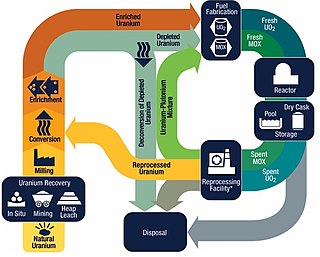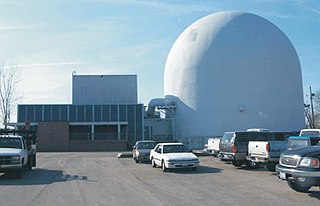
A nuclear reactor is a device used to initiate and control a fission nuclear chain reaction. Nuclear reactors are used at nuclear power plants for electricity generation and in nuclear marine propulsion. When a fissile nucleus like uranium-235 or plutonium-239 absorbs a neutron, it splits into lighter nuclei, releasing energy, gamma radiation, and free neutrons, which can induce further fission in a self-sustaining chain reaction. The process is carefully controlled using control rods and neutron moderators to regulate the number of neutrons that continue the reaction, ensuring the reactor operates safely, although inherent control by means of delayed neutrons also plays an important role in reactor output control. The efficiency of nuclear fuel is much higher than fossil fuels; the 5% enriched uranium used in the newest reactors has an energy density 120,000 times higher than coal.

A pressurized water reactor (PWR) is a type of light-water nuclear reactor. PWRs constitute the large majority of the world's nuclear power plants. In a PWR, the primary coolant (water) is pumped under high pressure to the reactor core where it is heated by the energy released by the fission of atoms. The heated, high pressure water then flows to a steam generator, where it transfers its thermal energy to lower pressure water of a secondary system where steam is generated. The steam then drives turbines, which spin an electric generator. In contrast to a boiling water reactor (BWR), pressure in the primary coolant loop prevents the water from boiling within the reactor. All light-water reactors use ordinary water as both coolant and neutron moderator. Most use anywhere from two to four vertically mounted steam generators; VVER reactors use horizontal steam generators.

The pebble-bed reactor (PBR) is a design for a graphite-moderated, gas-cooled nuclear reactor. It is a type of very-high-temperature reactor (VHTR), one of the six classes of nuclear reactors in the Generation IV initiative.

A nuclear meltdown is a severe nuclear reactor accident that results in core damage from overheating. The term nuclear meltdown is not officially defined by the International Atomic Energy Agency or by the United States Nuclear Regulatory Commission. It has been defined to mean the accidental melting of the core of a nuclear reactor, however, and is in common usage a reference to the core's either complete or partial collapse.

The nuclear fuel cycle, also called nuclear fuel chain, is the progression of nuclear fuel through a series of differing stages. It consists of steps in the front end, which are the preparation of the fuel, steps in the service period in which the fuel is used during reactor operation, and steps in the back end, which are necessary to safely manage, contain, and either reprocess or dispose of spent nuclear fuel. If spent fuel is not reprocessed, the fuel cycle is referred to as an open fuel cycle ; if the spent fuel is reprocessed, it is referred to as a closed fuel cycle.

A breeder reactor is a nuclear reactor that generates more fissile material than it consumes. These reactors can be fueled with more-commonly available isotopes of uranium and thorium, such as uranium-238 and thorium-232, as opposed to the rare uranium-235 which is used in conventional reactors. These materials are called fertile materials since they can be bred into fuel by these breeder reactors.
A loss-of-coolant accident (LOCA) is a mode of failure for a nuclear reactor; if not managed effectively, the results of a LOCA could result in reactor core damage. Each nuclear plant's emergency core cooling system (ECCS) exists specifically to deal with a LOCA.

The light-water reactor (LWR) is a type of thermal-neutron reactor that uses normal water, as opposed to heavy water, as both its coolant and neutron moderator; furthermore a solid form of fissile elements is used as fuel. Thermal-neutron reactors are the most common type of nuclear reactor, and light-water reactors are the most common type of thermal-neutron reactor.

The integral fast reactor (IFR), originally the advancedliquid-metal reactor (ALMR), is a design for a nuclear reactor using fast neutrons and no neutron moderator. IFRs can breed more fuel and are distinguished by a nuclear fuel cycle that uses reprocessing via electrorefining at the reactor site.

The Lucens reactor was a 6 MW experimental nuclear power reactor built next to Lucens, Vaud, Switzerland. After its connection to the electrical grid on 29 January 1968, the reactor only operated for a year before it suffered an accident on 21 January 1969. The cause was a corrosion-induced loss of heat dispersal leading to the destruction of a pressure tube which caused an adjacent pressure tube to fail, and partial meltdown of the core, resulting in radioactive contamination of the cavern.

Nuclear fuel refers to any substance, typically fissile material, which is used by nuclear power stations or other nuclear devices to generate energy.

The lead-cooled fast reactor is a nuclear reactor design that uses molten lead or lead-bismuth eutectic coolant. These materials can be used as the primary coolant because they have low neutron absorption and relatively low melting points. Neutrons are slowed less by interaction with these heavy nuclei so these reactors operate with fast neutrons.

A sodium-cooled fast reactor is a fast neutron reactor cooled by liquid sodium.

Spent nuclear fuel, occasionally called used nuclear fuel, is nuclear fuel that has been irradiated in a nuclear reactor. It is no longer useful in sustaining a nuclear reaction in an ordinary thermal reactor and, depending on its point along the nuclear fuel cycle, it will have different isotopic constituents than when it started.
This page describes how uranium dioxide nuclear fuel behaves during both normal nuclear reactor operation and under reactor accident conditions, such as overheating. Work in this area is often very expensive to conduct, and so has often been performed on a collaborative basis between groups of countries, usually under the aegis of the Organisation for Economic Co-operation and Development's Committee on the Safety of Nuclear Installations (CSNI).
KS 150 is a Gas Cooled Reactor using Heavy Water as a moderator (GCHWR) nuclear reactor design. A single example, A-1, was constructed at the Bohunice Nuclear Power Plant in Jaslovské Bohunice, Czechoslovakia. The power plant suffered a series of accidents, the worst being an accident on February 22, 1977, rated INES-4. Since 1979 the plant has been undergoing decommissioning.

The liquid fluoride thorium reactor is a type of molten salt reactor. LFTRs use the thorium fuel cycle with a fluoride-based molten (liquid) salt for fuel. In a typical design, the liquid is pumped between a critical core and an external heat exchanger where the heat is transferred to a nonradioactive secondary salt. The secondary salt then transfers its heat to a steam turbine or closed-cycle gas turbine.
The Ultra-High Temperature Reactor Experiment (UHTREX) was an experimental gas-cooled nuclear reactor run at Los Alamos National Laboratory between 1959 and 1971 as part of research into reducing the cost of nuclear power. Its purpose was to test and compare the advantages of using a simple fuel against the disadvantages of a contaminated cooling loop. It first achieved full power in 1969.
The Energy Multiplier Module is a nuclear fission power reactor under development by General Atomics. It is a fast-neutron version of the Gas Turbine Modular Helium Reactor (GT-MHR) and is capable of converting spent nuclear fuel into electricity and industrial process heat.

An organic nuclear reactor, or organic cooled reactor (OCR), is a type of nuclear reactor that uses some form of organic fluid, typically a hydrocarbon substance like polychlorinated biphenyl (PCB), for cooling and sometimes as a neutron moderator as well.















